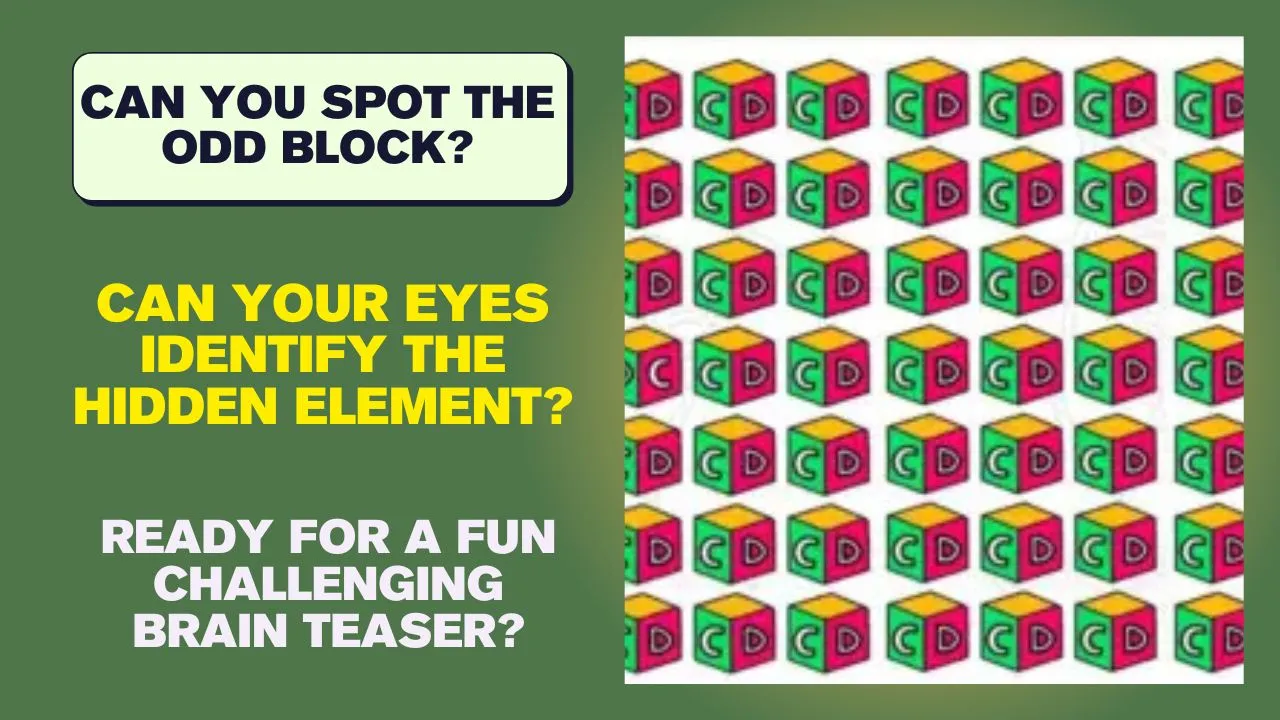Optical illusions have always fascinated people. They challenge how we see the world and force our brains to process information in unexpected ways. One such illusion that’s caught everyone’s attention is simple on the surface, but tricky in execution:
Can you find the odd block among a grid of nearly identical ones?
Seems easy, right? But don’t be fooled — this test is tougher than it looks and only those with sharp vision and focused attention will be able to crack it.
Contents
- 0.1 The Challenge: Spotting the Difference
- 0.2 Why Is It So Hard?
- 0.3 The Science Behind the Trick
- 0.4 How to Spot the Odd Block: Tips That Work
- 0.5 More Than Just Fun: Why Optical Illusions Are Good for You
- 0.6 Related posts:
- 1 Mind Puzzle: Spot the Secret Number in This Viral Optical Illusion
- 2 Can You Spot the Hidden Parrot? This Optical Illusion Is Stumping Everyone
- 3 Escape the Illusion: The Mirror Maze Challenge
The Challenge: Spotting the Difference
You’re shown a grid filled with blocks that look exactly the same — same size, same shape, same color. But hiding in plain sight is one block that’s just a little different. The twist? The difference is so subtle, you might overlook it unless you’re really paying attention.
This illusion is designed to test your visual acuity — your ability to catch even the slightest change in pattern, shade, alignment, or texture.

Why Is It So Hard?
Our brains are wired to recognize patterns, which helps us process what we see more quickly. But this also means we often miss small details that break those patterns. The odd block might have:
- A slightly different shade
- A small alignment shift
- A texture or border variation
Your mind wants to simplify the grid into one uniform image — and that’s exactly what makes spotting the odd block so challenging.
The Science Behind the Trick
Optical illusions play on how our brains interpret visual input. What our eyes see isn’t always what our brains process. Past experiences, expectations, and assumptions all influence how we perceive the world.
So when you scan a grid that looks consistent, your brain assumes uniformity. That tiny inconsistency — the odd block — often slips through the cracks unless you break that assumption and analyze the image piece by piece.
How to Spot the Odd Block: Tips That Work
Here are a few tricks to help you find the sneaky block:
-
Examine One Block at a Time
Don’t try to scan the whole grid at once. Focus on individual blocks. Notice anything slightly off in texture, shape, or angle? -
Look for Subtle Shading
Is one block lighter or darker than the others? Even a small difference in contrast can be the giveaway. -
Check Borders and Edges
Sometimes the difference lies in the edges of the block. Maybe the outline is slightly thicker, thinner, or misaligned. -
Watch for Misalignment
The odd block might be tilted or out of line by just a few pixels. Look carefully. -
Use Your Peripheral Vision
Surprisingly, looking slightly away from the image can make subtle differences stand out more clearly. -
Take Your Time
Don’t rush it. The more patient and focused you are, the better your chances of spotting the odd one out.
More Than Just Fun: Why Optical Illusions Are Good for You
These puzzles aren’t just entertaining — they’re great for your brain. Regularly engaging with visual challenges can:
- Improve attention to detail
- Boost problem-solving skills
- Enhance focus and concentration
- Train your brain to process information from different angles
And let’s be honest, they’re a fun way to break up the day and give your mind a little workout!
The “Spot the Odd Block” illusion may seem like a simple puzzle, but it pushes your brain to work harder — to question what it sees, and to search for what’s hidden in plain sight. Whether you spot the odd block right away or it takes you a while, the journey is half the fun.

So the next time you come across an optical illusion, pause, observe, and enjoy the challenge. You might just discover your eyes are sharper than you thought!

